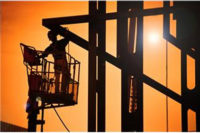A major contributor to the one-month drop in nonresidential indexes was a plunge in the PPI for diesel fuel, -11% for the month and -8.2% over 12 months. The one-month gain in residential PPIs is attributable in part to a 3.0% monthly increase in the PPI for lumber and plywood; that index fell 11% over 12 months. Among other important inputs, the PPI for aluminum mill shapes rose 1.9% and 11%; concrete products, 1.2% and 5.2%; steel mill products, 0.1% and 3.6%. The PPI for copper and brass mill shapes fell -4.5% for the month but rose 34% over 12 months; asphalt paving mixtures and blocks, -0.1% and 25%; and gypsum products, -0.1% and 3.2%.
BLS introduced a PPI for new office building construction, which measures the final cost of a building, including labor and profit, not just materials. That index rose 1.9% for the month and 6.9% from its June 2006 base. BLS has two other indexes for completed buildings: the warehouse index was up 1.3% for the month and 8.2% over 12 months; the school index fell 0.2% for the month but leaped 17.2% over 12 months.
“Escalating violence in [Guinea] has forced some of the world’s biggest aluminium producers to shut down operations and threatens to further boost prices of aluminum,” the Wall Street Journal reported on Friday. “Big aluminum users are now waiting to see how long the disruptions last. Industry officials say any big price increase from the violence could take some time to filter up through the supply chain, but prolonged disruptions could result in higher costs….prices have gained 8% this week, pushed higher in part by…violence in Guinea.”
Industrial production (IP) at mines, utilities and factories sank 0.5% in January, seasonally adjusted, mirroring a 0.5% rise in December and bringing the 12-month change to 2.6%, the Federal Reserve reported on Thursday. IP in manufacturing, which along with factory capacity utilization can indicate future demand for plant construction, slumped 0.7% in January after climbing 0.8% in December; over 12 months the index was up 1.8%. Output of construction supplies fell 1.0% in January and 2.8% over 12 months. Capacity utilization in manufacturing slipped to 79.6% of capacity, the first time in more than a year that it has been below the long-term average of 79.8%.
Housing starts imploded 14% in January, seasonally adjusted, and were 38% below the January 2006 level, the Census Bureau reported on Friday. Both December and January 2006 were much warmer and drier than normal, which may have led to more starts in those months than would otherwise have occurred. But building permits, generally a reliable guide to builder’s near-term intentions and not subject to current weather, fell 2.8% compared to December and 29% from January 2006. Single-family starts fell 11% and 39%; multi-family, 24% and 33%. Single-family permits sank 4% and 33%; multi-family, +0.4% and -16%.
The National Association of Home Builders reported on Thursday that its index of home builders’ sentiment, based on a monthly survey, with 50 as neutral, increased from 35 in January to 40 in February, up from a low of 30 last September and the highest level since June 2006. “All three component indexes registered improvement in February. The index gauging current single-family home sales gained six points to 42, while the component measuring the traffic of prospective buyers rose five points to 31…The index gauging sales expectations for the next six months jumped over the 50 threshold for the first time since last June, posting a seven-point gain to 55.”
The National Association of Realtors reported on Thursday that the median sales price of existing single-family houses (the price above which half of all sales occurred) fell 2.7% in the fourth quarter compared to one year earlier, the first annual drop in the 27-year history of the series. The median fell in 73 out of 149 metro areas, rose in 71, and was unchanged in five. The largest single-family home price increase was in the Atlantic City, N.J., area, 26%, followed by the Salt Lake City area, 23%, and Trenton-Ewing, New Jersey, 19%. At the bottom were three formerly fast-rising areas in Florida: Cape Coral-Fort Myers, -12%, Palm Bay-Melbourne, 17%, and Sarasota-Bradenton-Venice, -18%. USA Today (www.money.usatoday.com) posted the full list. Metro area condominium and cooperative prices-covering changes in 58 markets-show the national median existing condo price was down 2.1%, with decreases in 27 metros and increases in 31. The strongest condo price gains were in Austin-Round Rock, Texas, and Newark-Union, NJ-Pennsylvania, both up 16%, and Springfield, Massachusetts, 15%.

